 W
WArtiluc was a silver coin forged and used in the 17th century in the Republic of Ragusa that had its capital city in Dubrovnik, modern-day Croatia.
 W
WThe ashrafi was a gold coin issued by Muslim dynasties in the Middle East, Central Asia and South Asia. It was worth two mohurs.
 W
WThe batzen was a coin produced by Bern, Switzerland, from the 15th century until the mid-19th century.
 W
WIn the Middle Ages, the term bezant was used in Western Europe to describe several gold coins of the east, all derived ultimately from the Roman solidus. The word itself comes from the Greek Byzantion, ancient name of Constantinople, the capital of the Byzantine Empire.
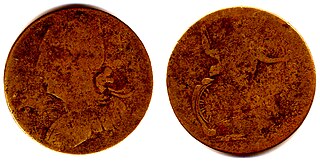 W
WBlacksmith tokens are a form of evasion currency that was in circulation primarily in Lower Canada and Upper Canada along with neighboring areas, such as the northern parts of New York and New England in the mid-1820 to 1830s. They were not, strictly speaking counterfeits, but instead skirted around the laws of the time by being similar to officially circulating coinage, but bearing different legends, or bearing no legends or dates at all, so it could not be claimed that they were truly imitating circulating coinage fully. The tokens were designed to resemble worn examples of English or Irish copper coinage, most often with a crude profile of either George II or George III in profile on the obverse and an image of Britannia or an Irish harp on the reverse. They were typically underweight when compared to officially sanctioned halfpenny coinage, but were accepted along with many other unofficially issued tokens due to a lack of sufficient small denomination coinage in circulation at the time.
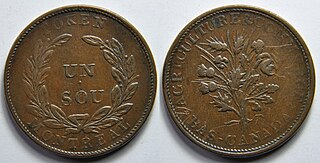 W
WBouquet sou were a series of tokens that were created for use primarily within Lower Canada in the mid- to late-1830s. Roughly equivalent in value to a half penny, the "bouquet sou" were so called because they displayed a group of heraldic flowers tied together with a ribbon on their obverse. The group of flowers were encircled by one of several legends, which might say "Trade & Agriculture / Lower Canada", "Agriculture & Commerce / Bas Canada" or some variant of these that might also substitute the name of the issuing bank. The other side most typically gave the denomination of "un sou", surrounded by a wreath and the words "Bank Token" and "Montreal". There are a large variety of these tokens, distinguished primarily by the number and variety of flowers that appear in the "bouquet", along with the differences in the legends that appeared on either side of the token. They were initially issued by the banks of Lower Canada, and were later imitated by speculators who produced tokens that looked similar, but were underweight for their denomination. These coins also circulated to Upper Canada, as at least one archeology dig attests. Large numbers of these tokens were produced and many examples can easily be obtained for only a few C$dollars, though a few rare varieties can command significantly higher prices.
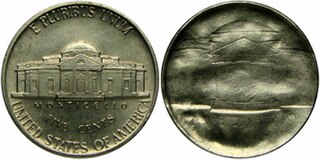 W
WIn coin collecting, brockage refers to a type of error coin in which one side of the coin has the normal design and the other side has a mirror image of the same design impressed upon it.
 W
WCeltic coinage was minted by the Celts from the late 4th century BC to the mid 1st century AD. Celtic coins were influenced by trade with and the supply of mercenaries to the Greeks, and initially copied Greek designs, especially Macedonian coins from the time of Philip II of Macedon and his son, Alexander the Great. Thus Greek motifs and even letters can be found on various Celtic coins, especially those of southern France.
 W
WThe Celtic currency of Britain were the various items and coins used as currency between approximately 200 BC and AD 60. The earliest currency consisted of various forms of iron bars. Coins were first imported in large numbers in around 150 BC and domestic minting began around 100BC. Coin production was largely ended by the Roman conquest of Britain, first by the Claudian invasion of AD 43 and later by the Defeat of Boudica in AD 60 or 61. Cast coins may have been produced for a few more years around Hengistbury Head. Exact dating of coins often changes in the light of new research.
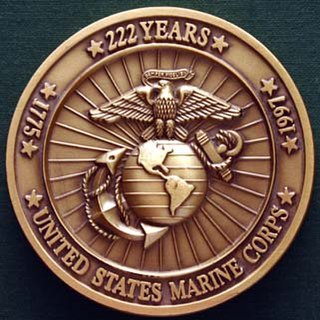 W
WA challenge coin is a small coin or medallion, bearing an organization's insignia or emblem and carried by the organization's members. Traditionally, they might be given to prove membership when challenged and to enhance morale. Some challenge coins have created controversy and their creators have been threatened with jail. They are also collected by service members and law enforcement personnel. Historically, challenge coins were presented by unit commanders in recognition of special achievement by a member of the unit. They could also be exchanged in recognition of visits to an organization.
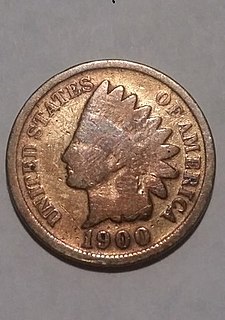 W
WCoin cleaning is the process of removing undesirable substances from a coin's surface in order to make it more attractive to potential buyers. The subject is controversial as no consensus exists among the numismatic community whether cleaning is necessary. Those that argue in favor of cleaning are also in dispute on which methods work best. It was once common practice to clean coins as the method was recommended by experts in the field. Solutions from pencil erasers to wire brushes and potassium cyanide were all used as cleaning agents with the goal to make the coin look brilliant again. When certified grading came into use in the mid 1980s though, the practice of cleaning coins diminished over time. Most coin experts have since come out against cleaning coins, as doing so can negatively effect them both in grade and value. If a potentially valuable coin must be cleaned then professional work is recommended. Commonly found coins are mentioned as ideal candidates for any attempted cleaning experiments.
 W
WCoin edges may be plain (smooth) or patterned, or a combination of both. They can also include lettering.
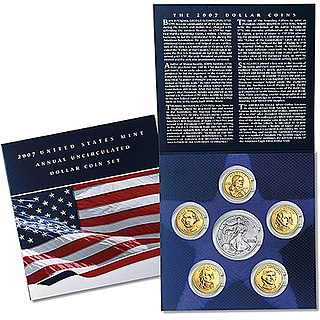 W
WA coin set, or mint set, is a collection of Uncirculated or Proof coins, released by a mint. Such sets are usually released annually and often called a year set. They include sets of all the circulating coins of that year, as well as sets of commemorative coins.
 W
WCoin collectors have various options for storing their coin collections. The various options depend on a few different requirements such as; protection from oxidation and other chemical damage, protection from mechanical damage, ease of viewing and organization, and protection from loss or theft.
 W
WA coin watch or medal watch comprises a watch inserted into a coin or medal.
 W
WThe croat was a silver coin of Catalonia introduced by Peter III of Aragon in 1285 and minted at Barcelona. The term "croat" derives from the Latin grossus denarius, great coin, a common term for silver coins of higher value than pennies. Peter III was inspired by the gros introduced by Louis IX of France.
 W
WThe Croeseid, anciently Kroiseioi stateres, was a type of coin, either in gold or silver, which was minted in Sardis by the king of Lydia Croesus from around 550 BC. Croesus is credited with issuing the first true gold coins with a standardised purity for general circulation, and the world's first bimetallic monetary system.
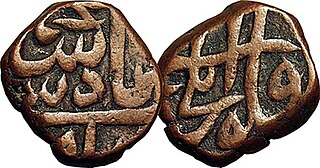 W
WA Dam was a small Indian copper coin. The coin was first introduced by Sher Shah Suri during his rule of India between 1540 and 1545, along with Mohur, the gold coin and Rupiya the silver coin. Later on, the Mughal Emperors standardised the coin along with other silver (Rupiya) and gold (Mohur) coins in order to consolidate the monetary system across India. A rupee was divided into 40 dams.
 W
WDam was a small coin, either silver, gold or copper first minted during between c. 1098 - 1126 CE., replacing old Licchavi coinage.
 W
WA debasement of coinage is the practice of lowering the intrinsic value of coins, especially when used in connection with commodity money, such as gold or silver coins. A coin is said to be debased if the quantity of gold, silver, copper or nickel in the coin is reduced.
 W
WThe ducat was a gold or silver coin used as a trade coin in Europe from the later Middle Ages until as late as the 20th century. Many types of ducats had various metallic content and purchasing power throughout the period. The gold ducat of Venice gained wide international acceptance, like the medieval Byzantine hyperpyron and the Florentine florin, or the modern British pound sterling and the United States dollar. In more recent usage, the ducat has been reinvented as slang terminology for a poker chip.
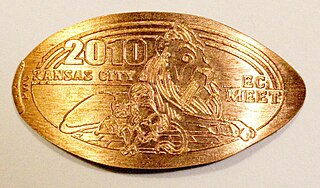 W
WAn elongated coin is one that has been flattened or stretched, and embossed with a new design. Such coins are often used as commemorative or souvenir tokens, and it is common to find coin elongation machines in tourism hubs, such as museums, amusement parks, and natural or man-made landmarks.
 W
WA numismatic essay is a coin prototype proposed for general sale or circulation.
 W
WThe fals was a medieval copper coin first produced by the Umayyad caliphate (661–750) beginning in the late 7th century. The name is a corruption of follis, a Roman and later Byzantine copper coin. The fals usually featured ornate Arabic script on both sides. Various copper fals were produced until the 19th century. Their weight varied, from one gram to ten grams or more.
 W
WCoin flipping, coin tossing, or head or tail is the practice of throwing a coin in the air and checking which side is showing when it lands, in order to choose between two alternatives, heads or tails, sometimes used to resolve a dispute between two parties. It is a form of sortition which inherently has two possible outcomes. The party who calls the side that the coin lands on wins.
 W
WThe term funeral coin is used for coins issued on the occasion of the death of a prominent person, mostly a ruling prince or a coin-lord. The obverse of such a coin usually depicts the portrait of the deceased; the reverse may show the coat of arms and important biographic data.
 W
WThe Griqua coinage was the first community coinage in South Africa and was introduced by the London Missionary Society.
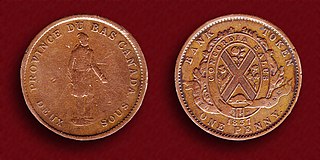 W
WThe Habitant token were a series of tokens that were created for use primarily within Lower Canada and were issued in 1837. Produced as a successor to the popular bouquet sous, these tokens depicted a Habitant on the obverse, a traditional depiction of a French-Canadian farmer in winter clothing, and the coat of arms for the City of Montreal on the reverse. The tokens were issued in both one penny/deux sous and half penny/un sou denominations by the leading commercial banks of Montreal. They were issued in large numbers and can be easily acquired by the modern collector, though some varieties are rare and command a premium.
 W
WThe history of coins extends from ancient times to the present, and is related to economic history and the history of mint. Coins are still widely used for monetary and other purposes.
 W
WThe hobo nickel is a sculptural art form involving the creative modification of small-denomination coins, essentially resulting in miniature bas reliefs. The US nickel coin was favored because of its size, thickness and relative softness. However, the term hobo nickel is generic, as carvings have been made from many different denominations.
 W
WThe akşa was the currency of the Tuvan People's Republic (Tannu-Tuva) between 1934 and 1944. It was subdivided into 100 kɵpejek. Akşa in the Tuvan language simply means "money".
 W
WManillas are a form of commodity money, usually made of bronze or copper, which were used in West Africa. They were produced in large numbers in a wide range of designs, sizes, and weights. Originating before the colonial period, perhaps as the result of trade with the Portuguese Empire, Manillas continued to serve as money and decorative objects until the late 1940s and are still sometimes used as decoration. In popular culture, they are particularly associated with the Atlantic slave trade.
 W
WMast stepping is the process of raising the mast of a boat. It may be a ceremonial occasion on a new boat, a necessary step, as in stepping the mast of a small sailing dinghy or gig, or simply routine, as following seasonal maintenance on a sailboat.
 W
WMechanical banks are small containers with a decorative mechanical action, used to store coins. They were originally intended to promote saving money among children in the mid-19th century. Frequently made of cast iron, mechanical banks were often creatively designed, depicting historical, legendary or everyday events to increase their appeal. Each bank performed a stunt or an action when a coin was dropped into a slot and a lever was pulled. The banks quickly became popular with children and adults alike and soon became a sought-after collector's item.
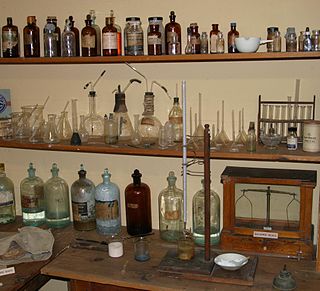 W
WA metallurgical assay is a compositional analysis of an ore, metal, or alloy, usually performed in order to test for purity or quality.
 W
WCoin debasement is the act of decreasing the amount of precious metal in a coin, while continuing to circulate it at face value. This was frequently done by governments in order to inflate the amount of currency in circulation; typically, some of the precious metal was replaced by a cheaper metal when the coin was minted. But when done by an individual, precious metal was physically removed from the coin, which could then be passed on at the original face value, leaving the debaser with a profit. Coin debasement was effected by several methods, including clipping and sweating.
 W
WIn numismatics, a mule is a coin or medal minted with obverse and reverse designs not normally seen on the same piece. These can be intentional or produced by error. This type of error is highly sought after by collectors, and examples can fetch high prices.
 W
WObverse and its opposite, reverse, refer to the two flat faces of coins and some other two-sided objects, including paper money, flags, seals, medals, drawings, old master prints and other works of art, and printed fabrics. In this usage, obverse means the front face of the object and reverse means the back face. The obverse of a coin is commonly called heads, because it often depicts the head of a prominent person, and the reverse tails.
 W
WA pattern coin is a coin which has not been approved for release, but produced to evaluate a proposed coin design. They are often off-metal strike, to proof standard or piedforts. Many coin collectors collect and study pattern coins because of their historical importance. Many of the world's most valuable coins are pattern coins; nearly 25 of the pieces listed in 100 Greatest US Coins are pattern coins.
The pfennig or penny is a former German coin or note, which was the official currency from the 9th century until the introduction of the euro in 2002. While a valuable coin during the Middle Ages, it lost its value through the years and was the minor coin of the Mark currencies in the German Reich, West and East Germany, and the reunified Germany until the introduction of the euro. Pfennig was also the name of the subunit of the Danzig mark (1922–1923) and the Danzig gulden (1923–1939) in the Free City of Danzig.
 W
WA piedfort is an unusually thick coin, often exactly twice the normal weight and thickness of other coins of the same diameter and pattern. Piedforts are not normally circulated, and are only struck for presentation purposes by mint officials, or for collectors, dignitaries and other VIPs. Piedfort is commonly misspelled as "piefort".
 W
WPiggy bank is the traditional name of a coin container normally used by children. The piggy bank is known to collectors as a "still bank" as opposed to the "mechanical banks" popular in the early 20th century. These items are also often used by companies for promotional purposes. The use of the name 'piggy bank' gave rise to its widely recognized 'pig' shape, and many financial service companies use piggy banks as logos for their savings products.
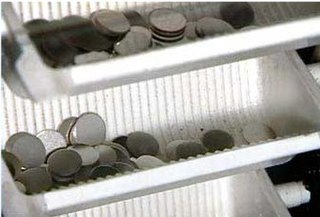 W
WA planchet is a round metal disk that is ready to be struck as a coin. An older word for planchet is flan. They are also referred to as blanks.
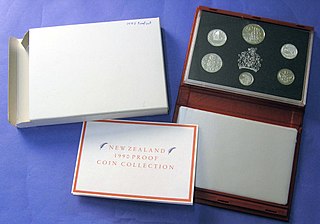 W
WProof coinage refers to special early samples of a coin issue, historically made for checking the dies and for archival purposes, but nowadays often struck in greater numbers specially for coin collectors (numismatists). Nearly all countries have issued proof coinage.
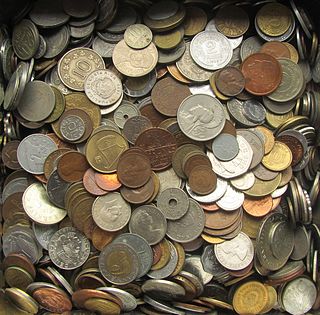 W
WA coin is a small, flat, round piece of metal or plastic used primarily as a medium of exchange or legal tender. They are standardized in weight, and produced in large quantities at a mint in order to facilitate trade. They are most often issued by a government. Coins often have images, numerals, or text on them. Obverse and its opposite, reverse, refer to the two flat faces of coins and medals. In this usage, obverse means the front face of the object and reverse means the back face. The obverse of a coin is commonly called heads, because it often depicts the head of a prominent person, and the reverse tails.
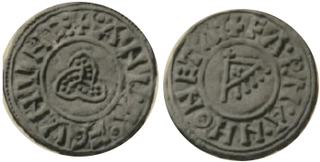 W
WThe Raven Banner Penny is a coin of the Norse-Gael Olaf Sihtricson who was the king of Jórvík between 941-944 and king of Dublin between 945-947 and 952-980.
 W
WThe rim of a coin is the raised part of the coin that completely encircles the perimeter on both obverse and reverse sides. Not to be confused with the edge of the coin, which is also known as its "third side".
 W
WIn Japanese, saisen (賽銭) is money offered to the gods or bodhisattvas. Commonly this money is put in a saisen box , a common item at Shinto shrines and Buddhist temples in Japan.
 W
WSiege money or money of necessity is a form of Notgeld that was issued in times of war or invasion, such as during a siege.
 W
WSiege money or money of necessity was minted in Newark-on-Trent in 1646 during the third and final siege (1645–1646) — the last year of the First English Civil War. To meet need for money, the besieged Royalists set up a mint that manufactured lozenge-shaped coins — half-crowns, shillings, ninepences, and sixpences.
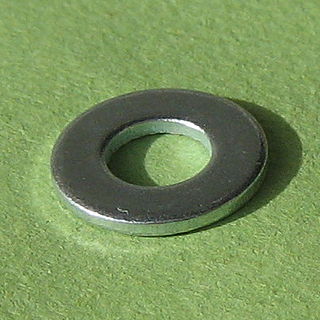 W
WA slug is a counterfeit coin that is used to make illegal purchases from a coin-operated device, such as a vending machine, payphone, parking meter, transit farebox, copy machine, coin laundry, gaming machine, or arcade game. By resembling various features of a genuine coin, including the weight, size, and shape, a slug is designed to trick the machine into accepting it as a real coin.
 W
WThe stater was an ancient coin used in various regions of Greece. The term is also used for similar coins, imitating Greek staters, minted elsewhere in ancient Europe.
 W
WThe Sundveda Hoard is a Viking Age hoard of 482 silver coins found in 2008 in Sundveda between Märsta and Sigtuna, not far from Stockholm in Sweden. It is the largest silver hoard found in the Mälaren region since 1827.
 W
WToning on a coin is the change of colour brought about through oxidization, which forms a thin layer of tarnish on the metal's surface. Coin toning can vary in aesthetics, and thus can alternately add or detract from a coin's value. Coins with unusual toning colours or patterns tend to be valued by coin collectors. Toning is most common on silver coins, but can be found on nickel, copper, gold, and other composition coins to a lesser extent.
 W
WA touch piece is a coin or medal believed to cure disease, bring good luck, influence people's behaviour, carry out a specific practical action, etc.
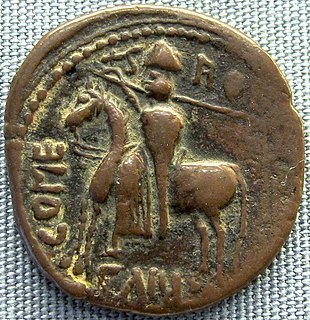 W
WThe trifollaro or trifollaris was a copper coin minted in southern Italy under the Normans. It was worth 120 nummi or 3 folles. The name trifollaro, used by scholars, was coined by the Italian numismatist Rodolfo Spahr. Contemporary sources do not use the name. Spahr interpreted the phrase tres follares aereos romesinam unam appretiatos in Falco of Benevento's discussion of the currency reform of 1140 as a reference to a new denomination of coin.
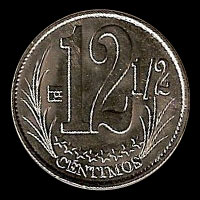 W
WThe Venezuelan twelve-and-a-half-céntimos-coin or, was a cupro-nickel money and that was worth one-eighth of a silver Venezuelan Bolivar (VEB), this round piece of metal was known also with the very popular nicknames of "Locha" or "Cuartillo".
 W
WThe Vexator Canadiensis tokens are thought to be politically satirical tokens produced in either Quebec City or Montreal sometime in the 1830s. The tokens present a very crude image of a vaguely male bust on their obverse, and a female figure on the reverse. The legends on either side were deliberately designed so that they are hard to definitively read, but are commonly known as the "vexators" based on a common interpretation of its obverse legend. Depending on the interpretation of the inscriptions, they can either be taken as a form of satirical protest against either an unpopular Upper Canada governor or William IV as a "tormentor of Canada", or more simply, depicting a fur trapper. Since both interpretations are possible, this ambiguity would allow the issuer from escaping being cited for sedition.
 W
WA denga was a Russian monetary unit with a value latterly equal to ½ kopek.